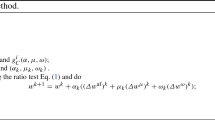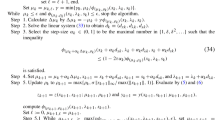Abstract
Recently, Ye, Tapia and Zhang (1991) demonstrated that Mizuno—Todd—Ye's predictor—corrector interior-point algorithm for linear programming maintains the O(\(\sqrt n \) L)-iteration complexity while exhibiting superlinear convergence of the duality gap to zero under the assumption that the iteration sequence converges, and quadratic convergence of the duality gap to zero under the assumption of nondegeneracy. In this paper we establish the quadratic convergence result without any assumption concerning the convergence of the iteration sequence or nondegeneracy. This surprising result, to our knowledge, is the first instance of a demonstration of polynomiality and superlinear (or quadratic) convergence for an interior-point algorithm which does not assume the convergence of the iteration sequence or nondegeneracy.
Similar content being viewed by others
References
I. Adler and R. Monteiro, “Limiting behavior of the affine scaling continuous trajectories for linear programming problems,”Contemporary Mathematics 114 (1990) 189–211.
A.S. El-Bakry, R.A. Tapia and Y. Zhang, “A study of indicators for identifying zero variables in interior-point methods,” TR91-15, Department of Mathematical Sciences, Rice University (Houston, TX, 1991).
O. Güler and Y. Ye, “Convergence behavior of some interior-point algorithms,” to appear in:Mathematical Programming (1993).
A.J. Hoffman, “On approximate solutions of systems of linear inequalities,”Journal of Research of the National Bureau of Standards 49 (1952) 263–265.
J. Ji, F. Potra, R.A. Tapia and Y. Zhang, “An interior-point method with polynomial complexity and superlinear convergence for linear complementarity problems,” Department of Mathematics, The University of Iowa (Iowa City, IA, 1991); also TR91-23, Department of Mathematical Sciences, Rice University (Houston, TX, 1991).
M. Kojima, Y. Kurita and S. Mizuno, “Large step interior-point algorithms for linear complementarity problems,” to appear in:SIAM Journal on Optimization.
M. Kojima, N. Megiddo and T. Noma, “Homotopy continuation methods for nonlinear complementarity problems,”Mathematics of Operations Research 16 (1991) 754–774.
M. Kojima, S. Mizuno and A. Yoshise, “A polynomial-time algorithm for a class of linear complementarity problems,”Mathematical Programming 44 (1989) 1–26.
K. McShane, “A superlinearly convergent O(\(\sqrt n \) L) iteration primal—dual linear programming algorithm,” manuscript, 2537 Villanova Drive (Vienna, VA, 1991).
S. Mehrotra and Y. Ye, “On finding the optimal face of linear programs,” Technical Report, Department of IE and MS, Northwestern University (Evanston, IL, 1991).
S. Mizuno, M.J. Todd, and Y. Ye, “On adaptive-step primal—dual interior-point algorithms for linear programming,” to appear in:Mathematics of Operations Research.
G. Sonnevend, J. Stoer and G. Zhao, “On the complexity of following the central path of linear programs by linear extrapolation,”Methods of Operations Research 63 (1989) 19–31.
R.A. Tapia, “On the role of slack variables in quasi-Newton methods for constrained optimization,” in: L.C.W. Dixon and G.P. Szegö, eds.,Numerical Optimization of Dynamic Systems (North-Holland, Amsterdam, 1980) pp. 235–246.
C. Witzgall, P.T. Boggs and P.D. Domich, “On the convergence behavior of trajectories for linear programming,”Contemporary Mathematics 114 (1990) 161–187.
Y. Ye, “On the finite convergence of interior-point algorithms for linear programming,”Mathematical Programming (Series B) 57 (1992) 325–335.
Y. Ye, R.A. Tapia and Y. Zhang, “A superlinearly convergent O(\(\sqrt n \) L)-iteration algorithm for linear programming,” TR91-22, Department of Mathematical Sciences, Rice University (Houston, TX, 1991).
Y. Zhang and R.A. Tapia, “A quadratically convergent polynomial primal—dual interior-point algorithm for linear programming,” to appear in:SIAM Journal on Optimization.
Y. Zhang, R.A. Tapia and J.E. Dennis, “On the superlinear and quadratic convergence of primal—dual interior-point linear programming algorithms,”SIAM Journal on Optimization 2 (1992) 304–323.
Y. Zhang, R.A. Tapia and F. Potra, “On the superlinear convergence of interior-point algorithms for a general class of problems,” to appear in:SIAM Journal on Optimization.
Author information
Authors and Affiliations
Additional information
Supported in part by NSF Grant DDM-8922636 and NSF Coop. Agr. No. CCR-8809615, the Iowa Business School Summer Grant, and the Interdisciplinary Research Grant of the University of Iowa Center for Advanced Studies.
Supported in part by NSF Coop. Agr. No. CCR-8809615, AFOSR 89-0363, DOE DEFG05-86ER25017 and ARO 9DAAL03-90-G-0093.
Supported in part by NSF Grant DMS-9102761 and DOE Grant DE-FG05-91ER25100.
Rights and permissions
About this article
Cite this article
Ye, Y., Güler, O., Tapia, R.A. et al. A quadratically convergent O(\(\sqrt n \) L)-iteration algorithm for linear programming. Mathematical Programming 59, 151–162 (1993). https://doi.org/10.1007/BF01581242
Received:
Revised:
Issue Date:
DOI: https://doi.org/10.1007/BF01581242




